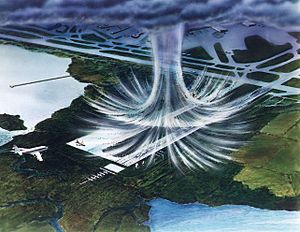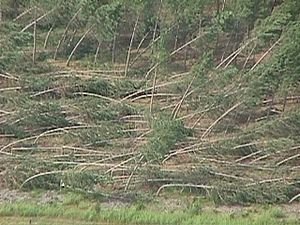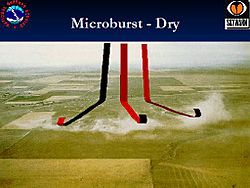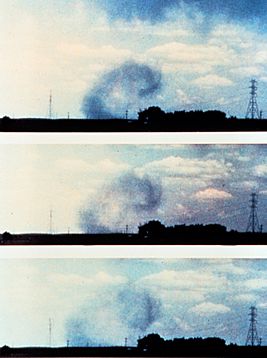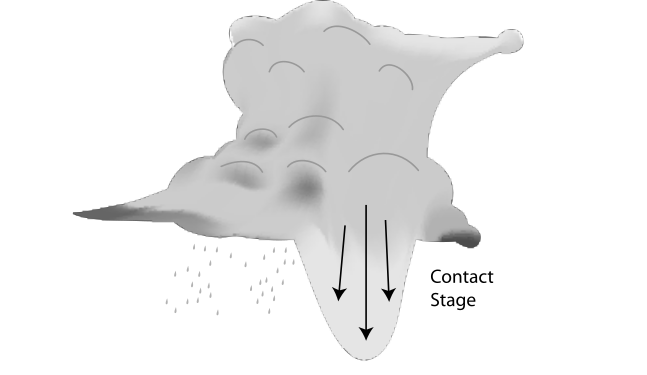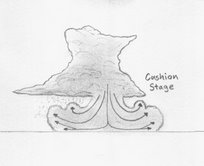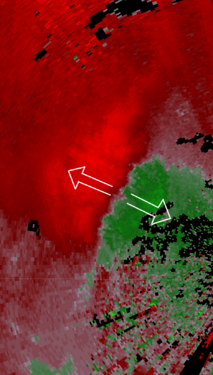Downburst facts for kids
A downburst is a strong burst of wind that rushes downward from a thunderstorm. When this powerful wind hits the ground, it spreads out in all directions, like water from a faucet hitting a sink. These winds can be very damaging, sometimes making people confuse them with tornadoes. However, tornadoes have winds that spin around a center, while downburst winds blow straight outward. Downbursts usually last only a few seconds to a few minutes. They are very strong downdrafts (air moving downwards) that happen inside thunderstorms.
Downbursts often form when air cooled by precipitation (rain or hail) falls quickly. As this cold, dense air hits the ground, it spreads out, causing strong winds. There are two main types:
- Dry downbursts happen with thunderstorms that produce very little rain.
- Wet downbursts come from thunderstorms with a lot of rain.
Downbursts can also be called microbursts if they are small (less than 4 km wide) or macrobursts if they are larger. A rare type called a heat burst happens when air warms up as it falls, causing very hot, dry winds. Downbursts create sudden changes in wind direction and speed, known as wind shear. This is very dangerous for aviation, especially when planes are landing or taking off. Pilots learn how to recognize and deal with wind shear during their training. Special equipment at airports also helps detect these dangerous winds.
Contents
What is a Downburst?
A downburst is like a column of sinking air that crashes into the ground and spreads out. These winds can be very strong, sometimes over 150 km/h (93 mph). The damage they cause looks different from tornado damage. Tornadoes leave a swirling pattern of damage, but downbursts cause damage that spreads out in straight lines from a central point. Because of this, the damage from downbursts is often called straight-line winds.
Downbursts without much rain, or with rain that evaporates before reaching the ground (called virga), are known as dry downbursts. Those that bring a lot of rain are called wet downbursts. Most downbursts are small, less than 4 km (2.5 miles) wide, and are called microbursts. Larger ones, over 4 km (2.5 miles) wide, are called macrobursts. Sometimes, many downbursts happen one after another over a huge area, creating a long-lasting storm system called a derecho. These can cover hundreds of kilometers and last for many hours, causing very strong straight-line winds.
Dry Microbursts
Dry microbursts happen when rain falls from a cloud into very dry air below. As the rain falls, it evaporates. This evaporation cools the air around it, making the air heavier and denser. This cold, dense air then rushes downwards, picking up speed. When it hits the ground, it spreads out in all directions, creating strong straight-line winds.
These microbursts usually come from thunderstorms with high cloud bases and little rain reaching the ground. The air below the cloud is very dry, which helps the rain evaporate quickly and cool the air.
Wet Microbursts
Wet microbursts are downbursts that bring a lot of rain to the ground. In these cases, the weight of the rain itself helps pull the air downwards. Also, the evaporation of rain and melting of hail cool the air, making it sink faster. Wet microbursts need more moisture in the air to form. It can be tricky for forecasters to predict exactly when and where wet microbursts will happen.
| Feature | Dry Microburst | Wet Microburst |
|---|---|---|
| Rainfall | Little or none | Moderate or heavy |
| Cloud Height | High up in the sky | Lower in the sky |
| Below Cloud | Rain evaporates before hitting ground (virga) | Heavy rain shaft |
| Main Cause | Air cooling from evaporation | Weight of rain and evaporative cooling |
Straight-Line Winds
Straight-line winds are very strong winds that blow in one direction, unlike the spinning winds of a tornado. They can cause a lot of damage, sometimes even without a tornado present. These winds often happen at the front edge of a thunderstorm's outflow, or directly from a downburst. They can gust over 200 km/h (124 mph) and last for several minutes. In the United States, these winds are common in spring. Very strong straight-line wind events, like derechos, can cause widespread damage.
These powerful winds can also be dangerous for boats and ships on the water.
How Downbursts Form
A downburst starts when hail or large raindrops fall through drier air. As they fall, the hail melts and the raindrops evaporate. This process takes heat from the surrounding air, making it much colder. Since cold air is heavier than warm air, it sinks very quickly towards the ground. When this cold air hits the ground or water, it spreads out rapidly, creating a strong burst of wind.
The areas directly under and next to the downburst experience the strongest winds and any rainfall. Also, because this cold air comes from higher up in the atmosphere, temperatures on the ground can drop suddenly. As the downburst spreads out, it quickly loses its strength and forms a distinctive "curl shape" at its edges. Most downbursts only last a few minutes before fading away, unless they are part of a larger storm system like a squall line or derecho. Even though they are short-lived, microbursts are a serious danger to planes and can cause major damage to buildings and property.
Downbursts go through three main stages:
- Contact Stage: The downdraft (sinking air) begins to fall from the cloud and quickly reaches the ground.
- Outburst Stage: The cold air from the downburst hits the ground and spreads out, creating a "curl" of wind.
- Cushion Stage: The winds at the edge of the curl continue to speed up, while the winds closer to the center slow down due to friction with the ground.
On a weather radar screen, a downburst looks like a pattern of winds moving towards and away from the radar, especially during the outburst and cushion stages.
Heat Bursts
A very rare type of downburst is called a heat burst. This happens when air that has been cooled by evaporating rain falls from a very high altitude. As it falls, the air gets compressed and heats up. Heat bursts usually happen at night, often behind a dying storm line. They can produce winds over 160 km/h (100 mph), bring extremely dry air, and can suddenly raise the ground temperature to over 38°C (100°F). Sometimes, they can last for several hours.
Danger to Airplanes
Downbursts, especially microbursts, are extremely dangerous for airplanes that are taking off or landing. This is because they create very strong wind shear, which is a sudden change in wind speed or direction over a short distance. Many serious airplane accidents have been linked to downbursts.
Here are some examples of incidents where downbursts were a factor:
- Eastern Air Lines Flight 66, John F. Kennedy International Airport – 24 June 1975
- Pan Am Flight 759, New Orleans International Airport – 9 July 1982
- Delta Air Lines Flight 191, Dallas/Fort Worth International Airport – 2 August 1985
- USAir Flight 1016, Charlotte/Douglas International Airport – 2 July 1994
- Sosoliso Airlines Flight 1145, Port Harcourt International Airport - 10 December 2005
- ADC Airlines Flight 053, Nnamdi Azikiwe International Airport - 29 October 2006
- Bhoja Air Flight 213, Islamabad International Airport – 20 April 2012
- Aeroméxico Connect Flight 2431, Durango International Airport - 31 July 2018
A microburst can cause an airplane to crash when it's trying to land or just after taking off. As a plane approaches to land, pilots try to slow it down. When a microburst hits, the plane might first experience a strong headwind, which makes the airspeed suddenly increase. An inexperienced pilot might try to slow the plane down even more. But then, as the plane flies through the microburst, it enters a strong tailwind and downward air flow. This causes a sudden drop in the amount of air flowing over the wings, which means the wings produce less lift. With less lift and strong downward air, the plane might not have enough power to stay in the air and could stall. If this happens at a low altitude, the pilots won't have enough time or space to recover.
The strongest microburst ever recorded happened at Andrews Field, Maryland, on August 1, 1983, with winds reaching 240.5 km/h (149.4 mph).
Danger to Buildings
Downbursts can also cause significant damage to buildings and other structures on the ground.
- On June 21, 2023, a powerful downburst in the Houston area caused winds of 156 km/h (97 mph) at George Bush Intercontinental Airport. This storm left over 300,000 customers without power and damaged at least 243 homes. It was strong enough to flip a small plane at Hooks Airport.
- On May 21, 2022, a very strong downburst hit Ottawa, Ontario, Canada. Winds reached about 190 km/h (118 mph) over an area 36 km (22 miles) long and 5 km (3 miles) wide. This storm, part of a larger derecho, caused widespread damage and power outages, and tragically, 10 people lost their lives. It was one of Canada's most damaging wind storms ever, costing over $875 million in damages.
- On March 31, 2019, a very destructive downburst hit the Bara and Parsa Districts in Nepal. The winds lasted 30-45 minutes, flattening many buildings and severely damaging others. This led to 28 deaths and hundreds of injuries.
- On May 15, 2018, a powerful storm with downbursts and tornadoes moved through New York and Connecticut. Nearly half a million people lost power, and 5 people died. Winds were recorded over 160 km/h (100 mph).
- On April 3, 2018, a wet microburst hit William P. Hobby Airport in Texas, causing an aircraft hangar to partly collapse and damaging six business jets.
- On August 9, 2016, a wet microburst struck Cleveland Heights, Ohio. The storm developed quickly, bringing 129 km/h (80 mph) winds that knocked down hundreds of trees and power poles. Over 45,000 people lost power, and some homes were without electricity for days.
- On September 16, 2010, a wet macroburst with winds of 201 km/h (125 mph) hit parts of Central Queens in New York City. It caused huge damage to trees, buildings, and cars over an area 13 km (8 miles) long and 8 km (5 miles) wide. About 3,000 trees were knocked down, and one person died when a tree fell on a car.
- On May 2, 2009, a microburst flattened a lightweight steel building used by the Dallas Cowboys football team in Irving, Texas.
- On May 13, 1989, a microburst with winds over 153 km/h (95 mph) hit Fort Hood, Texas. It damaged over 200 U.S. Army helicopters and about 20% of the fort's buildings. The cost of repairs was estimated to be over $600 million.
Images for kids
See also
 In Spanish: Reventón (meteorología) para niños
In Spanish: Reventón (meteorología) para niños


